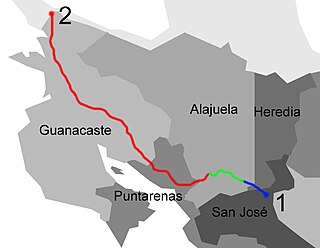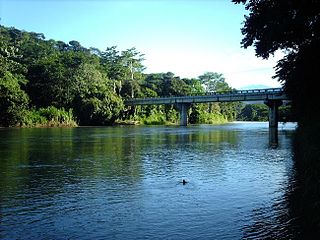
The Pan-American Highway is a network of roads stretching across the Americas and measuring about 30,000 kilometres (19,000 mi) in total length. Except for a break of approximately 106 km (66 mi) across the border between southeast Panama and northwest Colombia, called the Darién Gap, the roads link almost all of the Pacific coastal countries of the Americas in a connected highway system. According to Guinness World Records, the Pan-American Highway is the world's longest "motorable road". It is only possible to cross by land between South America and Central America—the last town in Colombia to the first outpost in Panama—by a difficult and dangerous hike of at least four days through the Darién Gap, one of the rainiest areas of the planet.

San José is a province of Costa Rica. It is located in the central part of the country, and borders the provinces of Alajuela, Heredia, Limón, Cartago and Puntarenas. The provincial and national capital is San José. The province covers an area of 4,965.9 km². and has a population of 1,404,242.
(San) Isidro or (San) Ysidro may refer to:

The Greater Metropolitan Area of Costa Rica, is the largest urban agglomeration in Costa Rica, comprising areas of high population density surrounding the capital, San José, which geographically corresponds to the Central Valley and extended to include the Guarco Valley, where some of the cantons of the Cartago province are located.

San Isidro de El General is the first district of the canton of Pérez Zeledón, in the southern part of the province of San José in Costa Rica, as well as the name of said district's main city.
Pocosol is a district of the San Carlos canton, in the Alajuela province of Costa Rica.

National Primary Route 39, or just Route 39 is a National Road Route of Costa Rica, located in the San José province. Its official name is Paseo de la Segunda República, is also known as Carretera de Circunvalación, and is an incomplete ring road encircling the central districts of San José canton, the capital of the country.

National Secondary Route 126, or just Route 126 is a National Road Route of Costa Rica, located in the Alajuela, Heredia provinces. It connects Route 3 and Route 4.

National Primary Route 35, or just Route 35 is a National Road Route of Costa Rica, located in the Alajuela province, and it is a road that serves the central north area of Costa Rica.

National Primary Route 32, or just Route 32 is a National Road Route of Costa Rica, located in the San José, Heredia, Limón provinces. It connects the central valley and Greater Metropolitan Area to the Caribbean coast of the country.

National Primary Route 27, or just Route 27 is a National Road Route of Costa Rica, is a route which connects the Greater Metropolitan Area to Caldera Port and the Pacific coast of the country.
National Tertiary Route 606, or just Route 606 is a National Road Route of Costa Rica, located in the Guanacaste, Puntarenas provinces. It is known as Carretera a Monteverde, between Route 1 in Puntarenas province and Monteverde. It is the main access road to the dairy farms and tourist-attraction rain forests of Monteverde.

National Primary Route 1, formally known as Carretera Interamericana Norte, is the northern segment of the Pan-American Highway that traverses Costa Rica.
National Secondary Route 252, is an arterial road from Route 2 to Route 210 in Curridabat.
National Secondary Route 243, or just Route 243 is a National Road Route of Costa Rica, located in the San José, Puntarenas provinces. It connects Route 2 and Route 34.

National Primary Route 34, official name Carretera Pacífica Fernández Oreamuno, and popularly known as Carretera Costanera Sur, or just Route 34, is a National Road Route and scenic route of Costa Rica, located in the Alajuela, Puntarenas provinces that connects Route 27 and Route 2 mostly along the central and south Pacific coast of the country, and is the recommended route over the Pan-American Highway when traveling between the south of the country to the Greater Metropolitan Area.

Interurbano Line, is a commuter railway line in Costa Rica, operated by the national public railway operator Incofer. The line connects the provinces of Alajuela, Heredia, San José and Cartago.
National Secondary Route 251, or just Route 251 is a National Road Route of Costa Rica, located in the San José, Cartago provinces.
National Secondary Route 222, or just Route 222 is a National Road Route of Costa Rica, located in the San José, Cartago provinces.
National Secondary Route 221, or just Route 221 is a National Road Route of Costa Rica, located in the San José, Cartago provinces.














